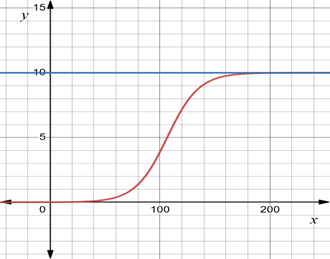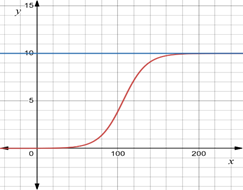
a.
To find: Graph of derivative of fruit fly population. What unit should be used for horizontal and vertical axis.
a.
Answer to Problem 29E
The graph of
Explanation of Solution
Given:
The given Function for profit is:
Where
Calculation: To draw the graph of above function it is required to substitute different values of
Let’s take
Substitute
Substitute
Similarly, more points can be found and trace them on graph.
The graph of

b.
To find: What values of
b.
Answer to Problem 29E
The values of
Explanation of Solution
Given:
The given Function for profit is:
Where
The graph of

Calculation:
The curve start increasing at
c.
To find: Draw the graph of
c.
Answer to Problem 29E
The value of
Explanation of Solution
Given:
The given Function for profit is:
Where
Concept used: Numerical derivative is defined as:
NDER
Calculation:
The derivative of
The graph of

The value of
d.
To find: What is the profit when marginal profit is greatest.
d.
Answer to Problem 29E
The marginal profit is greatest at
Explanation of Solution
Given:
The given Function for profit is:
Where
The graph of

Calculation:
It is clear from the graph that marginal profit is maximum at
Now substitute
The profit is 5 when marginal profit is greatest.
e.
To find: What is the profit when 50,100,125,150,175,300 units are sold respectively.
e.
Answer to Problem 29E
The profit when 50,100,125,150,175,300 units are sold is 0.1960 ,3.90, 7.83 ,9.5,9.9 respectively.
Explanation of Solution
Given:
The given Function for profit is:
Where
Calculation:
Substitute
Substitute
Substitute
Substitute
Substitute
f.
To find: What is
f.
Answer to Problem 29E
Explanation of Solution
Given:
The given Function for profit is:
Where
Calculation:
Maximum profit is 10.
f.
To find: Is there practical reasoning that where profit is maximum explain?
f.
Answer to Problem 29E
There is an asymptote at
Explanation of Solution
Given: The given Function for profit is:
Where
Calculation:
The graph of above function is given below:

There is asymptote at
Chapter 2 Solutions
Advanced Placement Calculus Graphical Numerical Algebraic Sixth Edition High School Binding Copyright 2020
 Calculus: Early TranscendentalsCalculusISBN:9781285741550Author:James StewartPublisher:Cengage Learning
Calculus: Early TranscendentalsCalculusISBN:9781285741550Author:James StewartPublisher:Cengage Learning Thomas' Calculus (14th Edition)CalculusISBN:9780134438986Author:Joel R. Hass, Christopher E. Heil, Maurice D. WeirPublisher:PEARSON
Thomas' Calculus (14th Edition)CalculusISBN:9780134438986Author:Joel R. Hass, Christopher E. Heil, Maurice D. WeirPublisher:PEARSON Calculus: Early Transcendentals (3rd Edition)CalculusISBN:9780134763644Author:William L. Briggs, Lyle Cochran, Bernard Gillett, Eric SchulzPublisher:PEARSON
Calculus: Early Transcendentals (3rd Edition)CalculusISBN:9780134763644Author:William L. Briggs, Lyle Cochran, Bernard Gillett, Eric SchulzPublisher:PEARSON Calculus: Early TranscendentalsCalculusISBN:9781319050740Author:Jon Rogawski, Colin Adams, Robert FranzosaPublisher:W. H. Freeman
Calculus: Early TranscendentalsCalculusISBN:9781319050740Author:Jon Rogawski, Colin Adams, Robert FranzosaPublisher:W. H. Freeman
 Calculus: Early Transcendental FunctionsCalculusISBN:9781337552516Author:Ron Larson, Bruce H. EdwardsPublisher:Cengage Learning
Calculus: Early Transcendental FunctionsCalculusISBN:9781337552516Author:Ron Larson, Bruce H. EdwardsPublisher:Cengage Learning





